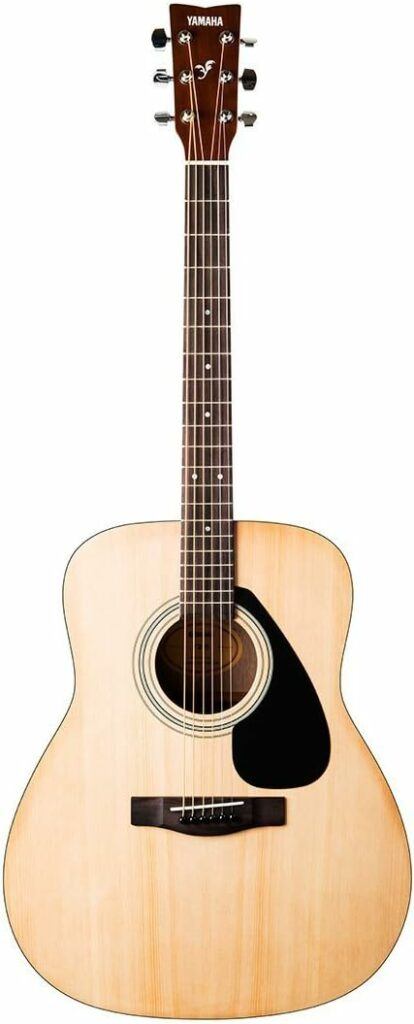Yamaha F310 vs Fender CD-60: A Comprehensive Comparison
When choosing an entry-level acoustic guitar, two models often stand out: the Yamaha F310 and the Fender CD-60. Both guitars are highly regarded for their quality and affordability, making them popular options for beginners. However, while they may seem similar at first glance, there are key differences between the two that can influence which one is right for you. In this article, we’ll compare the Yamaha F310 and Fender CD-60 across various factors such as build quality, sound, playability, and price.

Overview of Yamaha F310
The Yamaha F310 is a renowned acoustic guitar from Yamaha’s entry-level lineup, known for its durability and balanced tone. It is often recommended as one of the best beginner acoustic guitars on the market, offering excellent value for its price.
Key Features of the Yamaha F310:
- Body: Spruce top with Meranti back and sides
- Neck: Nato wood
- Fretboard: Rosewood
- Body shape: Dreadnought (smaller and slightly shallower than standard dreadnoughts)
- Finish: Gloss
- Tone: Bright, clear sound with good projection
- Playability: Comfortable for beginners due to its slightly smaller body size
The Yamaha F310 offers a balanced sound, making it suitable for a range of music styles from folk to pop. Its smaller dreadnought body makes it more comfortable for beginners, especially those with smaller hands.
Overview of Fender CD-60
The Fender CD-60 is a solid contender in the beginner guitar market and is part of Fender’s affordable line of acoustics. Known for its rich tone and sturdy construction, it’s often a go-to choice for those starting their guitar journey.
Key Features of the Fender CD-60:
- Body: Spruce top with Mahogany back and sides
- Neck: Nato wood
- Fretboard: Walnut
- Body shape: Full-size dreadnought
- Finish: Gloss
- Tone: Warm, deep bass tones with good resonance
- Playability: Slightly larger than the F310, offering a fuller sound
The Fender CD-60 is known for its full-bodied dreadnought shape and its rich, resonant sound, especially in the lower frequencies. It’s ideal for strumming and players looking for a guitar with a big, bold sound.
Build Quality
- Yamaha F310: The F310 features a spruce top with meranti back and sides, making it a robust, durable instrument. Meranti is a less expensive wood, but it provides decent sound quality. The nato neck offers a good balance between durability and playability, while the rosewood fretboard adds to its comfortable feel.
- Fender CD-60: The Fender CD-60 also comes with a spruce top, but its mahogany back and sides give it a warmer, richer tone compared to the F310’s meranti wood. The nato neck and walnut fretboard provide good durability, but some may prefer the rosewood fretboard found on the Yamaha.
Verdict: Both guitars offer solid build quality for their price range, but the Fender CD-60 edges out slightly with its mahogany back and sides, which contribute to a fuller sound and more durability.
Sound Quality
- Yamaha F310: The F310 offers a bright, clear sound with a balanced tone. While the bass is not as pronounced as on larger dreadnoughts, it still delivers decent low-end depth. Its projection and volume are more than adequate for home practice and small gatherings.
- Fender CD-60: The CD-60 is known for its richer, warmer tone due to the mahogany back and sides. It has a deeper bass response and overall better resonance than the F310, making it a good choice for players who prefer a fuller, more rounded sound. The full-sized dreadnought body enhances its volume and projection.
Verdict: If you prefer a brighter tone with a focus on the mid-range and treble, the Yamaha F310 is a great option. For those looking for a warmer, more resonant sound with deeper bass, the Fender CD-60 is the better choice.
Playability
- Yamaha F310: The F310’s slightly smaller body size compared to a full dreadnought makes it more comfortable to hold, especially for beginners, younger players, or those with smaller hands. The action (string height) on the F310 is generally low out of the box, making it easier to press down the strings.
- Fender CD-60: The CD-60, with its full-size dreadnought body, may feel bulkier to beginners, especially those not used to larger guitars. However, it offers a comfortable neck profile, and the string action is usually well set up, though it can vary from guitar to guitar.
Verdict: The Yamaha F310 wins in terms of comfort for beginners due to its smaller body size, but the Fender CD-60 offers better sound projection for those who can manage a larger guitar.
Price
- Yamaha F310: The F310 is generally more affordable than the CD-60, making it a great option for beginners on a tight budget.
- Fender CD-60: The CD-60 is slightly more expensive, but it offers better build quality and sound. It’s still within the budget-friendly range, making it accessible to beginners.
Verdict: If price is a major consideration, the Yamaha F310 is the more affordable option, but if you’re willing to spend a bit more for better sound and build quality, the Fender CD-60 is worth the extra investment.
Conclusion
Both the Yamaha F310 and the Fender CD-60 are excellent choices for beginner guitarists, but they cater to slightly different preferences.
- Choose the Yamaha F310 if you’re looking for an affordable, comfortable guitar with a brighter tone and easier playability for beginners.
- Choose the Fender CD-60 if you want a guitar with a warmer, richer sound, better resonance, and are comfortable with a full-size dreadnought body.
Ultimately, both guitars offer great value, and your choice will depend on whether you prioritize comfort and budget (Yamaha F310) or sound quality and build (Fender CD-60).


